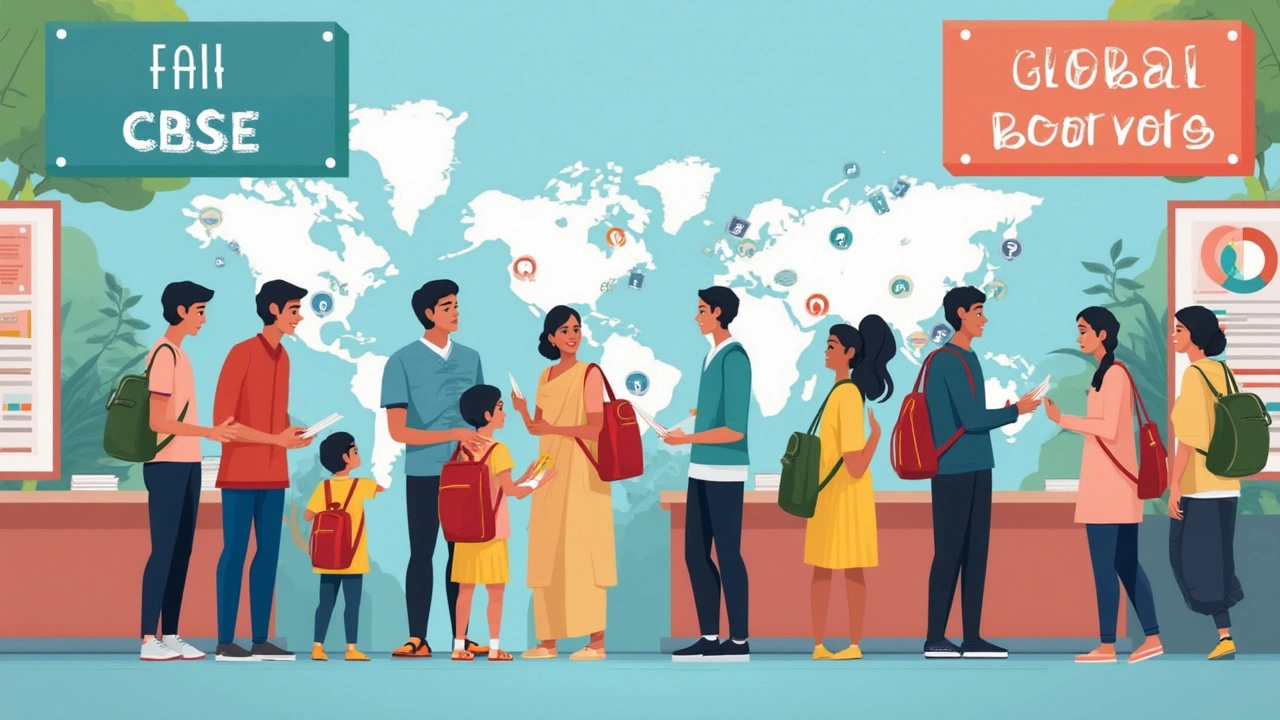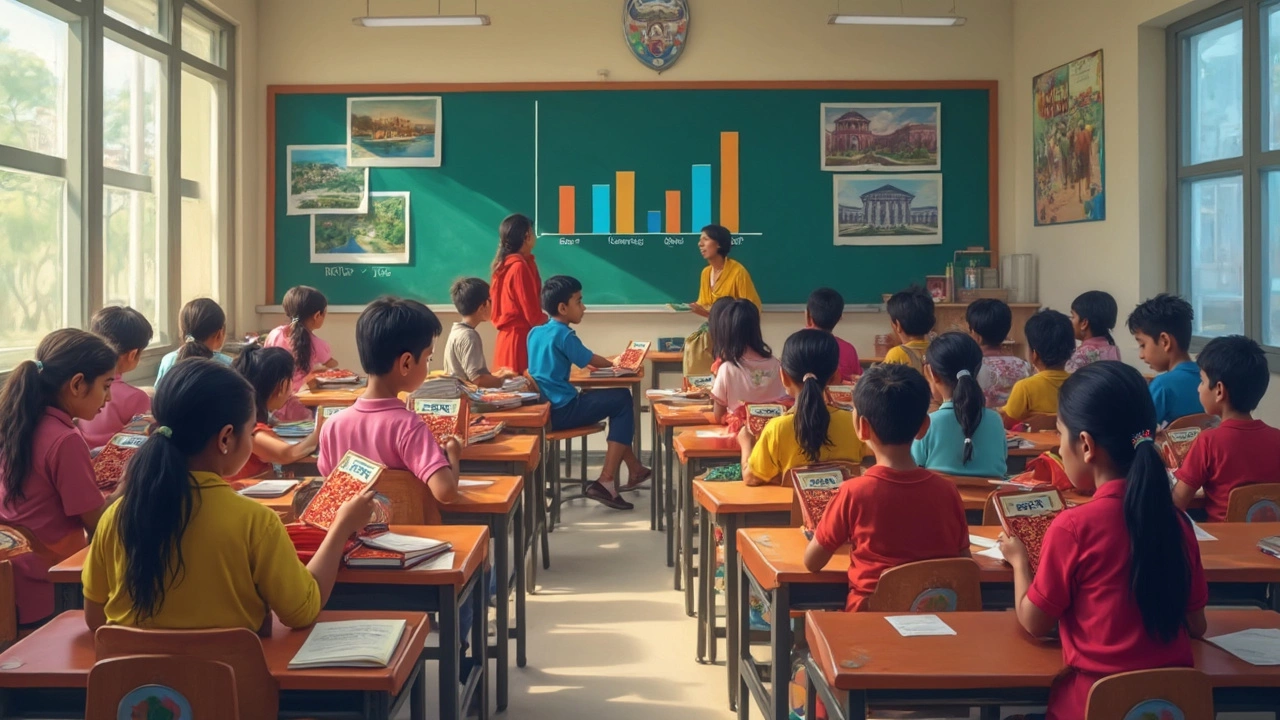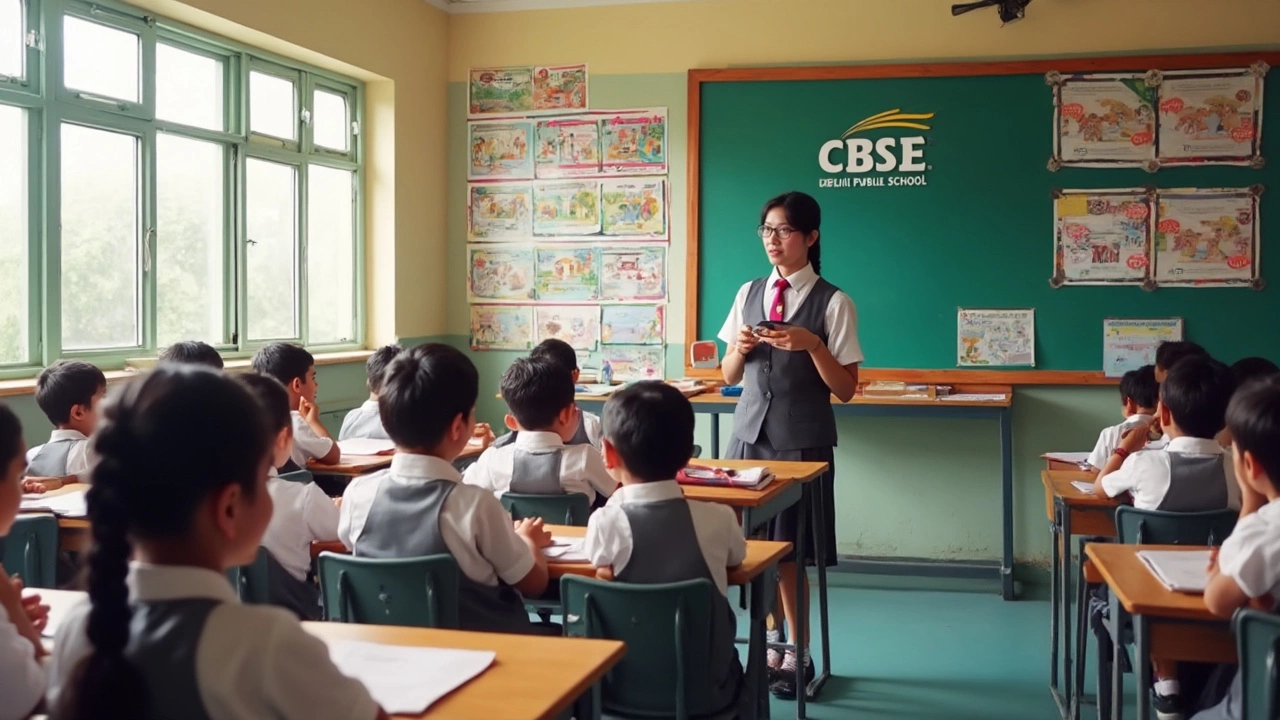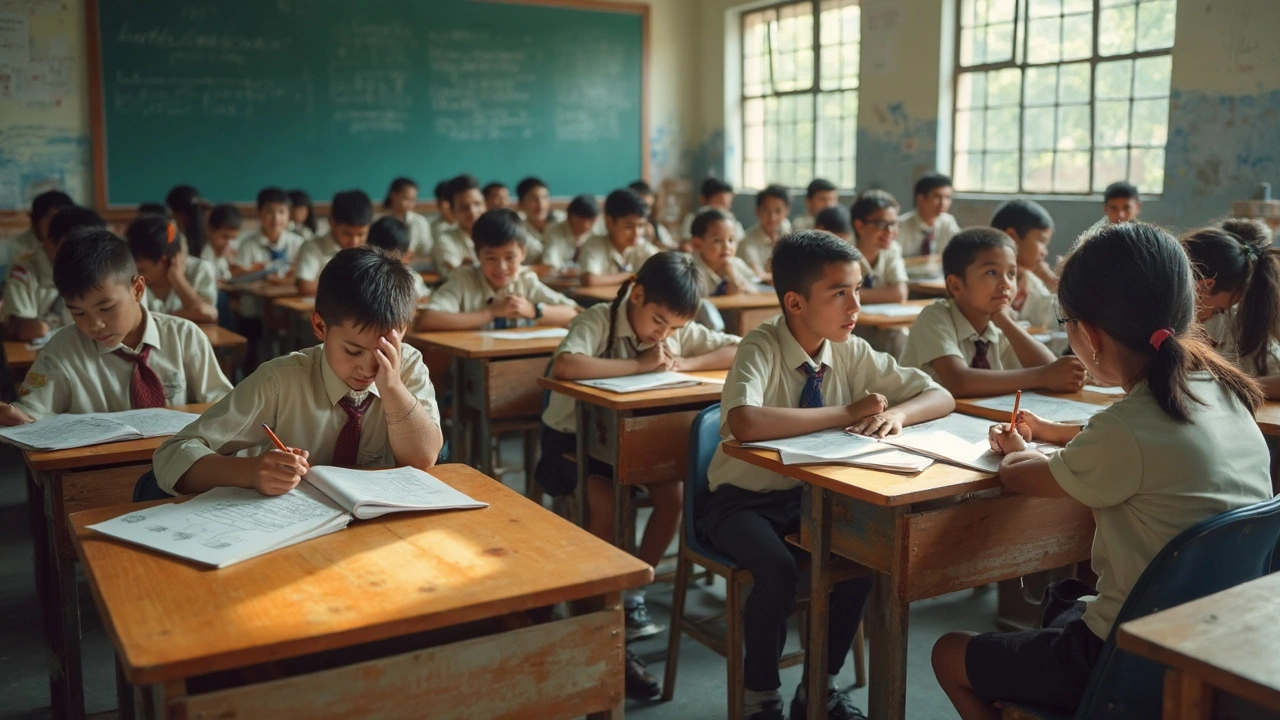Ask ten parents anywhere from Delhi to Dubai which school board rules them all, and chances are, CBSE pops up faster than you can say 'syllabus.' The Central Board of Secondary Education—CBSE for short—has practically become a household name, especially if you or your kids are aiming to crack those competitive exams in India.
But here's something people don't always realize: popular doesn't mean the same thing for everyone. Are we talking total number of students? Number of countries where a board is followed? Or maybe even the kind of opportunities it opens up for kids after school. All these factors stir up the debate about which board actually holds the crown worldwide.
If you're on the hunt for solid info to help shape a big decision—like picking the right board for your child's future—you're in the right place. The first step is digging into what makes a board 'popular,' then seeing how CBSE really stacks up against others you keep hearing about.
- What Does 'Most Popular' Even Mean?
- CBSE at a Glance
- CBSE vs Other Major Boards
- CBSE's Worldwide Reach: Myths and Facts
- Why Do Parents and Students Choose CBSE?
- Tips for Picking the Right Board for You
What Does 'Most Popular' Even Mean?
When people ask which school board is the "most popular," things can get confusing fast. Some folks look at the total number of students enrolled. Others check how many countries follow a certain syllabus. You might even factor in things like acceptance by colleges, the number of affiliated schools, or how often the board pops up in Google searches.
Let's break down the main ways people judge popularity with cold, hard facts:
- Total Student Enrollment – This is the classic metric. In 2024, the CBSE had over 24,000 schools affiliated with it and more than 20 million students enrolled. That's a gigantic number by any standard.
- Number of Countries – Boards like International Baccalaureate (IB) and Cambridge Assessment (CAIE) stretch into over 160 countries, making them kings of the "global reach" stat. CBSE now has nearly 240 schools overseas, mostly in Asia and the Middle East.
- Recognition – Some boards open more doors worldwide, especially for university admissions in English-speaking countries.
- Curriculum Influence – Does the syllabus shape what schools in other countries teach? For example, the American and British systems impact many private schools globally.
To give you the big picture, check out this quick table comparing major boards:
| Board | # of Students | # of Schools | Countries |
|---|---|---|---|
| CBSE | 20 million+ | 24,000+ | 25 |
| ICSE | 2.5 million | 2,700+ | 2 |
| IB | 2 million | 5,700+ | 160+ |
| Cambridge (CAIE) | 1.3 million | 10,000+ | 160+ |
Numbers tell part of the story. The real "popularity" depends on what matters to you—massive scale, global acceptance, or a certain teaching style. Each factor can tip the scale based on your family’s plans, college dreams, or even plans to move abroad. It’s less about right or wrong and more about what fits best for your situation.
CBSE at a Glance
Think of the CBSE as the backbone of school education for millions in India and the Indian diaspora. The Board started all the way back in 1962 and hasn’t stopped growing since. Today, it covers over 28 countries and connects more than 28,000 schools worldwide. That means if you hear someone say they studied under the CBSE syllabus, they could literally be anywhere—from a suburb in Mumbai to a campus in Singapore.
What’s so special about CBSE? For one, it follows a uniform, structured approach. The syllabus balances academic rigor with real-world skills, preparing kids not just for exams, but for life outside the classroom. The Board famously sets the pattern for big-league entrance exams like JEE and NEET, so if college in India is your goal, CBSE gives you a head start.
Check out some quick numbers that show just how massive CBSE really is:
| Detail | Number |
|---|---|
| Year Founded | 1962 |
| Schools Affiliated Globally | 28,500+ |
| Countries Present | 28 |
| Students Appearing for Class 10 Exams (2024) | 2.5 million+ |
| Students Appearing for Class 12 Exams (2024) | 1.6 million+ |
CBSE isn’t just huge; it’s tech-savvy too. They rolled out online exams, digital results, and even AI-driven sample paper generators in recent years. For schools, there’s lots of support—teacher training, online content, and updated safety guidelines. This keeps things moving smoothly, even when the world throws a curveball (like it did during COVID-19).
The Board’s medium of instruction is English and Hindi, so students from different language backgrounds aren’t left out. Syllabus updates happen every few years, keeping things current—last major one was in 2023, focusing more on critical thinking and less on rote learning.
So, whether you want consistency, national exam prep, or international recognition, CBSE’s wide network and flexible curriculum make it a go-to pick for a ton of families worldwide.
CBSE vs Other Major Boards
Alright, let’s break down how CBSE stacks up when you throw it in the ring with other big boards like ICSE, IB, and Cambridge (IGCSE). Each board has its own vibe, and honestly, picking one can feel like picking a phone—you have to go with what fits your needs and goals best.
CBSE is the biggest board in India by a huge margin. According to CBSE's own stats from 2024, over 27,000 schools in India and about 240 schools abroad follow their syllabus. It’s recognized by most Indian colleges, and almost every major entrance exam uses the CBSE pattern. If you’re dreaming of engineering or medical school in India, CBSE lines up best with those entrance tests. The focus? Solid grounding in science, math, and the core hit parade of subjects. It’s kind of the all-rounder—you get national reach, easier school transfers, and less exam pressure compared to some other boards.
Now, flip to ICSE (Council for the Indian School Certificate Examinations). It’s more detailed. Some say the curriculum is a bit heavier, especially for English, literature, and social sciences. If you’re looking for board recognition worldwide—especially if you want to study abroad—ICSE gets a few extra points, especially in English-speaking countries. But fewer Indian schools follow it (about 2,300 by 2024), so transferring between cities isn’t as smooth as with CBSE.
Let’s talk international: IB (International Baccalaureate) and Cambridge (IGCSE). These two are big outside India—in over 140 countries. They’re known for creative thinking, projects, and real-world learning. Kids learn to analyze and present, not just memorize. IB is especially heavy on assignments and presentations. Cambridge IGCSE is more exam-focused but still makes students think out of the box. If your eyes are set on foreign colleges or you plan to move countries, these boards look golden on a resume.
Quick side-by-side:
| Board | Number of Schools (2024) | Curriculum Focus | Best For |
|---|---|---|---|
| CBSE | 27,000+ (India & 240 abroad) | Core academics, competitive exams | Flexibility, transfers, Indian entrance tests |
| ICSE | 2,300+ (mainly India) | Language, arts, international recognition | English fluency, studying abroad |
| IB | 5,500+ (worldwide) | Research, assignments, world view | Foreign schools, analytical skills |
| Cambridge (IGCSE) | 10,000+ (globally) | Critical thinking, subject flexibility | International colleges, creative fields |
Picking the “best” board comes down to your needs. If you want smooth transfers, solid entrance test prep, and a familiar system, CBSE is hard to beat. If you’re eyeing schools outside India or want kids to build research and presentation skills, think IB or Cambridge. If top English and depth in arts matter, ICSE has you covered. There’s no universal winner, just what works best for your journey.

CBSE's Worldwide Reach: Myths and Facts
There’s a lot of buzz about CBSE being everywhere. Some folks even assume it’s the go-to board for international students outside India. Is that actually true? Let’s pick apart what’s real and what’s just talk.
First off, CBSE (the CBSE board) started as a way to make school education inside India consistent, but it quickly expanded its reach. As of June 2025, CBSE has around 28,000 schools across India, but what surprises people is its presence in other countries—there’s CBSE-affiliated schools in over 28 nations, not just places with a big Indian community like the UAE and Singapore, but also in places like Russia and Japan.
| Country | No. of CBSE Schools (approx.) |
|---|---|
| India | 27,800+ |
| UAE | 75 |
| Singapore | 5 |
| Oman | 21 |
| Qatar | 14 |
| Saudi Arabia | 11 |
| Other countries | ~20 total |
Now, here are some myths and the hard facts:
- Myth: CBSE is the most common board worldwide.
Fact: It’s big in India and the Middle East, but globally, the International Baccalaureate (IB) and Cambridge boards actually have more international schools. - Myth: All CBSE schools abroad are exactly like those in India.
Fact: Overseas schools follow the main CBSE curriculum, but they often tweak lessons to add in local languages or culture. - Myth: CBSE is for NRIs only.
Fact: Yes, it’s popular with Indians living abroad, but many international parents also pick it for stable academics and easier transfer if kids return to India.
So why does CBSE really stand out overseas? Simple answer: Indian expat families want schooling that lines up with Indian entrance exams and universities. Plus, the predictability helps if a family moves between countries. Still, if you walk into a random international school in, say, the US or Europe, you’re way more likely to see Cambridge or IB than CBSE on offer. That’s just how the numbers stack up.
One more thing: CBSE’s exam system and grading are familiar territory for a lot of universities and workplaces in Asia and the Middle East. But when it comes to North America or Europe, international boards like IB tend to carry more weight for college admissions.
Why Do Parents and Students Choose CBSE?
The CBSE syllabus wins a lot of hearts for being easy to move with. Whether your job takes you from Mumbai to Muscat, or you’re planning moves for better work, finding a CBSE-affiliated school is usually a breeze. This board is also famous for its straightforward approach—no confusing jargons, just clear explanations and practical knowledge that actually helps in real-life situations and exams.
One huge pull for CBSE is its close tie with competitive tests in India like JEE and NEET. These exams use much of the CBSE curriculum, so students feel right at home when prepping for the big leagues. Here’s how parents and students see the board’s perks:
- National Recognition: Most colleges, especially government ones, are built around the CBSE syllabus. It’s easier to match up requirements if you studied under CBSE.
- Smoother Transfers: Families who move states or countries love how uniform the curriculum is because their kids can switch schools without missing a beat.
- Less Rote, More Understanding: The board tries to push understanding over old-school cramming. So, your child isn’t just memorizing—there’s real learning going on.
- Reasonable Exams: CBSE papers are set up to test logic and basics, not tricky exceptions and heavy theory.
- English Medium Focus: Schools all over India and even in the Middle East stick to English, prepping students for both Indian and global opportunities.
Here’s a quick look at some CBSE stats that back up the buzz:
| Stat | Figure | Year/Source |
|---|---|---|
| Schools Affiliated Worldwide | Over 27,000 | CBSE official data, 2024 |
| India Exam Candidates (Class 10 & 12) | Nearly 4 million | CBSE Exam Report, 2023-24 |
| Number of Countries with CBSE Schools | 28+ | CBSE International Wing, 2024 |
Here’s what The Times of India once quoted a Delhi parent as saying about the board:
“With CBSE, my son found it much easier to adapt, especially when my job transferred us to Dubai. The syllabus follows the same structure everywhere and students aren’t left catching up.”
For parents anxious about college admissions, CBSE’s compatibility with almost every major Indian exam is like having a fast pass. Kids who want to be ready for anything—from engineering to medicine, or even a sudden family relocation—often feel CBSE keeps the doors wide open for them.
Tips for Picking the Right Board for You
Choosing a school board is more than just following what your neighbor did. Each board, whether it’s CBSE, ICSE, IB, or even your local state board, shines in different ways depending on what you and your kid want for the future.
- Think about future goals: If you’re set on engineering or medicine in India, CBSE might line up better with entrance exams like JEE and NEET. Their syllabus matches these national tests almost word for word.
- Look at the curriculum style: CBSE sticks to a more straightforward approach with clear, direct textbooks. It’s practical and helps you focus. ICSE and IB, in contrast, lean into projects, essays, and developing language skills.
- Check school availability: CBSE schools are everywhere, not just in India but also in spots like Dubai, Singapore, and Kuala Lumpur. That means easy transfers if you move around for work or family.
- Affordability: On average, CBSE is much more wallet-friendly than IB or international schools. Big cities in India show a massive gap: annual CBSE fees usually range from ₹30,000–₹80,000, while IB schools can start at ₹3 lakh and soar higher.
- Global recognition: If plans point outside India after Class 12, IB and Cambridge boards might be easier for admissions abroad. But many top universities worldwide now also accept CBSE marksheets.
If you’re someone who likes numbers, here’s a quick breakdown that puts the choices side by side:
| Board | Number of Schools (Global) | Main Focus | Avg. Fee per Year (India) |
|---|---|---|---|
| CBSE | Over 28,000 | Entrance Exam Alignment | ₹30,000–₹80,000 |
| ICSE | 2,300+ | Depth/Language/Arts | ₹50,000–₹1,20,000 |
| IB | 5,500+ | Analysis/Projects | ₹3 lakh–₹9 lakh |
| Cambridge | 10,000+ | Critical Thinking | ₹2 lakh–₹7 lakh |
So what’s the bottom line? Start with your goals—college dreams, affordability, moving plans, and how your kid learns best. Visit a couple of schools, ask about actual classroom practices, and talk to current parents if you can. You want a system that plays to your child's strengths, not just what’s popular nearby. Get that right, and the board itself becomes a lot less stressful to pick.


